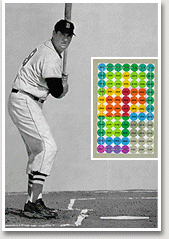There are three things I would emphasize to any hitter before even considering the rudiments of a good swing. These three things are more constant than the swing itself, and every bit as important.
|
 | Get A Good Ball To Hit - The first rule in the book that Rogers Hornsby originally impressed on me long ago. |
| |
You can see in the strike zone picture what I considered my happy areas, where I consistently hit the ball hard for high averages, and the areas graded down to those spots I learned to lay off, especially that low pitch on the outside 3 ½ inches from the plate. Ty Cobb once said, “Ted Williams sees more of the ball than any man alive - but he demands a perfect pitch. He takes too many bases on balls.” I didn’t resent that. I had 20-10 vision. A lot of guys can see that well. I couldn’t “see” the bat hit the ball, but I knew by the feel of it. A good carpenter doesn’t have to see the head of the hammer strike the nail but he still hits it square every time. A hitter learns in time where his happy zones are. There isn’t a hitter living who can hit a high ball as well as he can a low, or visa-versa, or outside as well as inside. All hitters have areas they like to hit in. But you can’t beat the fact that you’ve got to get a good ball to hit.
| 
Ted's "Happy Zone"
(click for larger view)
|
 |
Proper Thinking. The second rule that you must always take up there with you. Have you done your homework? What’s this guy’s best pitch? What did he get you out on last time? I remember one time Hal Newhouser of Detroit dusted me off, then struck me out on three pitches, the last one a sharp letter-high fast ball. When I came to the bench I was livid. Rip Russell made a crack, and I said, “Listen, I’ll bet five bucks if he throws the same pitch again I’ll hit it out.” Newhouser did, and I did. Proper thinking is 50 percent of effective hitting, and it is more than just doing your homework on a pitcher or studying the situation in a game. It is “anticipating”, too, when you are at the plate, and a lot of hitters will say that is college talk for “guessing” and some will be heard to say in a loud voice, “don’t do it!” They’re wrong. Guessing, or anticipating, goes hand in hand with proper thinking. A simple example: If a pitcher is throwing fast balls and curves and only the fast balls are in the strike zone, you would be silly to look for a curve, wouldn’t you?
|
 |
Be Quick With The Bat. The third rule applies all the time ~ there are several sections in my book, The Science of Hitting, that will help you with mechanics which you should read in conjunction with quickness to have complete understanding. Your practice time will make your mechanics automatic.
You have to think in terms of making everything quicker. How do you do that? You choke up a little bit. You quit trying to pull. You think more about that push swing, that 90-degree impact from the direction of the pitch. You think about hitting the ball back through the box. Joe DiMaggio, Joe Cronin, George Kell, Lou Boudreau, Harvey Kuenn - they could do it. Rod Carew, George Brett, Wade Boggs, Don Mattingly and Pete Rose are probably the most flexible hitters around today. When you’ve shortened up and quickened up, you can wait longer, you get fooled less, you become more consistent getting wood on the ball. Psychologically, becoming a good two-strike hitter inspires confidence. A batter knows he can still hit with authority.
|
No comments:
Post a Comment